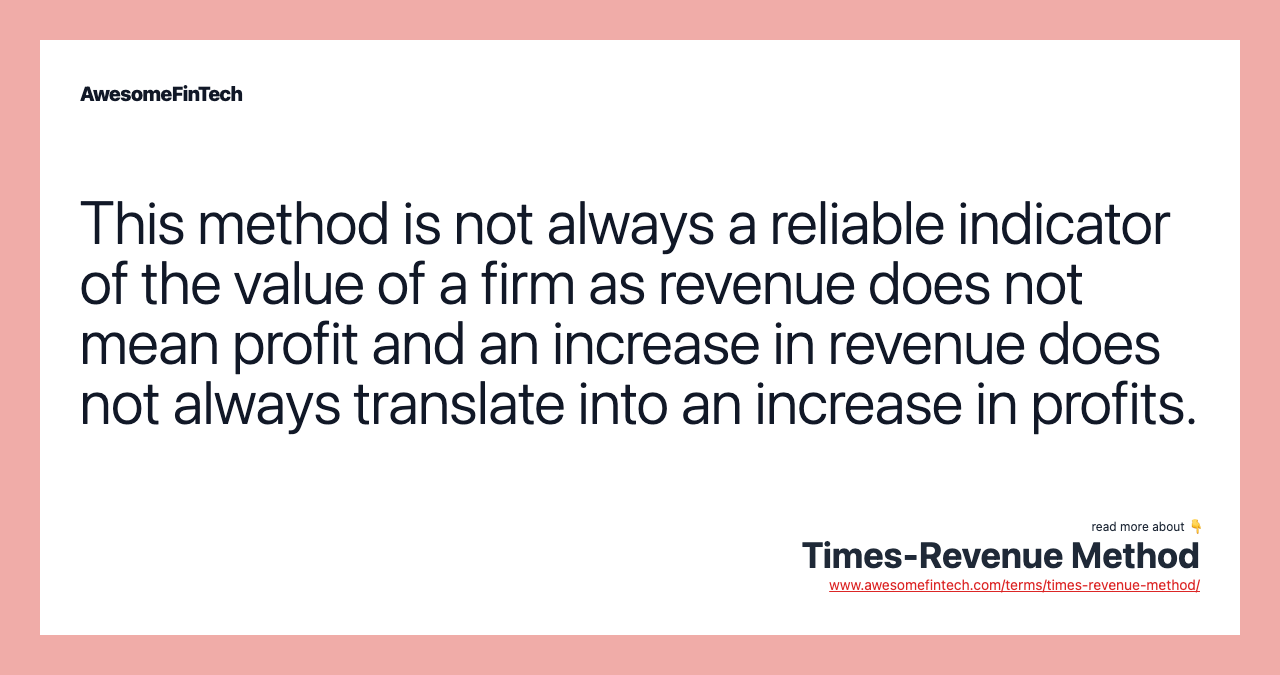Times-Revenue Method
The times-revenue method is a valuation method used to determine the maximum value of a company. The times-revenue (or multiples of revenue) method is a valuation method used to determine the maximum value of a company. A company with a low percentage of recurring revenue or consistent low forecasted revenue, such as a service company, may be valued at 0.5 times revenue. The value of the multiple used for evaluating the company’s value using the times-revenue method is influenced by a number of factors including the macroeconomic environment, industry conditions, etc. The times-revenue method is a valuation method used to determine the maximum value of a company.

What Is the Times-Revenue Method?
The times-revenue method is a valuation method used to determine the maximum value of a company. The times-revenue method uses a multiple of current revenues to determine the "ceiling" (or maximum value) for a particular business. Depending on the industry and the local business and economic environment, the multiple might be one to two times the actual revenues. However, in some industries, the multiple might be less than one.



Understanding How the Times-Revenue Method Works
Small business owners might determine the value of the company to aid in financial planning or in preparation for selling the business. It can be challenging to calculate a business' value, especially if the value is largely determined by potential future revenues. Several models can be used to determine the value, or a range of values, to facilitate business decisions.
The times-revenue method is used to determine a range of values for a business. The figure is based on actual revenues over a certain period of time (for example, the previous fiscal year), and a multiplier provides a range that can be used as a starting point for negotiations. In effect, the times-revenue method attempts to value a business by valuing its stream of sales cash flows.
Depending on the period for which the revenue is considered or on the method of revenue measurement employed, the value of the multiple can vary. Some analysts use the revenue or sales recorded on proforma financial statements as actual sales or a forecast of what future sales will be. The multiplier used in business valuation depends on the industry.
Small business valuation often involves finding the absolute lowest price someone would pay for the business, known as the "floor," often the liquidation value of the business' assets, and then determining a ceiling that someone might pay, such as a multiple of current revenues. Once the floor and ceiling have been calculated, the business owner can determine the value, or what someone may be willing to pay to acquire the business. The value of the multiple used for evaluating the company’s value using the times-revenue method is influenced by a number of factors including the macroeconomic environment, industry conditions, etc.
The times-revenue method is also referred to as "multiples of revenue method."
Special Considerations
The times-revenue method is ideal for younger companies with earnings that are either non-existent or very volatile. Also, companies that are poised to have a speedy growth stage, such as software-as-a-service firms, will base their valuations on the times-revenue method.
The multiple used might be higher if the company or industry is poised for growth and expansion. Since these companies are expected to have a high growth phase with a high percentage of recurring revenue and good margins, they would be valued in the three to four times revenue range.
On the other hand, the multiplier used might be closer to one of the business is slow-growing or doesn't show much growth potential. A company with a low percentage of recurring revenue or consistent low forecasted revenue, such as a service company, may be valued at 0.5 times revenue.
Criticism of the Times-Revenue Method
The times-revenue method is not always a reliable indicator of the value of a firm. This is because revenue does not mean profit. Likewise, an increase in revenue does not necessarily translate into an increase in profits. To get a more accurate picture of the current real value of a company, earnings must be factored in. Thus, the multiples of earnings, or earnings multiplier, is preferred to the multiples of the revenue method.
Related terms:
Certified Valuation Analyst (CVA)
Certified Valuation Analyst (CVA) is a professional designation that signifies a high standard of competence in the field of valuing businesses. read more
Business Valuation , Methods, & Examples
Business valuation is the process of estimating the value of a business or company. read more
Earnings Multiplier
The earnings multiplier relates a company's current stock price to its per-share earnings. read more
Earnings Power Value (EPV)
Earnings power value (EPV) is a technique for valuing stocks by making assumptions about the sustainability of current earnings and the cost of capital. read more
Liquidation Value
Liquidation value is the total worth of a company's physical assets if it were to go out of business. The liquidation value is the value of company real estate, fixtures, equipment, and inventory. read more
Maximum Wage
A maximum wage is a price ceiling on compensation paid to employees. read more
Mergers and Acquisitions (M&A)
Mergers and acquisitions (M&A) refers to the consolidation of companies or assets through various types of financial transactions. read more
Recurring Revenue
Recurring revenue is the portion of a company's revenue that is highly likely to continue in the future. read more
Terminal Value (TV) & Calculation
Terminal value (TV) determines the value of a business or project beyond the forecast period when future cash flows can be estimated. read more